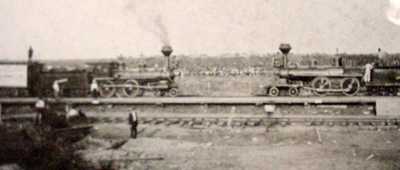Positive Train Control
The original deadline, set by Congress, to install this system was in 2015, but none of the railroads in the US made it. The deadline was unachievable and did not take into account the complexity of the issue. Each railroad runs different engine and car equipment, with unique signal and switching systems on the tracks. Custom hardware and software must be designed, manufactured and installed on board trains, on the tracks and switches, and in railroad offices and signal rooms. The extended deadline is in December 2018 and few railroads will make that deadline either, but not for lack of trying.
nj.com: Does this preventable train crash highlight Christie's failure to fund transportation?
DottyParker said:
nj.com: Does this preventable train crash highlight Christie's failure to fund transportation?
I think it does.
jimmurphy said:
The original deadline, set by Congress, to install this system was in 2015, but none of the railroads in the US made it. The deadline was unachievable and did not take into account the complexity of the issue. Each railroad runs different engine and car equipment, with unique signal and switching systems on the tracks. Custom hardware and software must be designed, manufactured and installed on board trains, on the tracks and switches, and in railroad offices and signal rooms. The extended deadline is in December 2018 and few railroads will make that deadline either, but not for lack of trying.
They didn't try. They did not want to spend the money. Countries in Europe and Asia are managing this.
ps - The NYC subways have positive train control in tunnels going downhill and in many stations. Its simple but it works. The red/yellow/signal signal lights have a switch (stop arm) which is up when the light is red. The up switch hits a trip arm stick that is physically attached to each train car which when tripped causes the train to go into emergency stop. Train speed control is based on timing the red light signals. For example, going into a tunnel the initial light is green or yellow, the next is red (could be yellow with the one following red). Passing the green light turns that light red and starts a timer for the next lights, which then turns yellow after a timed interval. If the train goes to fast, it will hit the red light before it turns yellow causing the train to go into emergency.
This has been around for about 50 years.
DottyParker said:
nj.com: Does this preventable train crash highlight Christie's failure to fund transportation?
http://www.nj.com/opinion/index.ssf/2016/09/a_preventable_train_crash_highlights_christies_fai.html#incart_river_index
Unfortunately its not just Christie's failure - past and present NJ state politicians do not know the meaning of 'Trust Fund' let alone fiduciary responsibility. On a national scale, the government is just as guilty of infra-structure neglect. Cross the border into Canada for a glimpse of the 21st century.
There's a lot of blame to spread around. I only find it of interest with regard to Christie, because his "brand" is Mr. Tough' Talkin' Truth Teller, the man who tells the voters the unvarnished truths they may not want to hear, but must hear. A guy who really did that would have given voters the bad news about the TTF and the state of our mass transit and would have suggested some hard choices to deal with it.
The guy's a fraud
ml1 said:
There's a lot of blame to spread around. I only find it of interest with regard to Christie, because his "brand" is Mr. Tough' Talkin' Truth Teller, the man who tells the voters the unvarnished truths they may not want to hear, but must hear. A guy who really did that would have given voters the bad news about the TTF and the state of our mass transit and would have suggested some hard choices to deal with it.
The guy's a fraud
+1
Now I'm not an engineer and I know zero about the mechanics of train locomotion, but I would think that a PTC system based on GPS (which I believe the current systems are not) would not be difficult to create and install. Apparently the current PTC systems are enormously complex, expensive and have to be customized for each location.
Sounds like a boondoggle to me, but I'll happily stand corrected if someone knows more about the current systems.
As for who to blame, I put it squarely at the feet of Reaganism and it's infection of the economic minds of a generation of politicians, both Dem and Repub, though mostly obviously Repub. Reaganism has allowed pols to convince people that the government is just too incompetent to be trusted with tax money to do important things. Infrastructure has been allowed to shamefully degrade across the country.
I assume that's part of Hartmann's point above. Haven't watched the video yet.
Not directed at anyone in particular - really!
I currently work as a scheduling consultant to the MTA. One of the big projects in progress is positive train control. It is not as simple as many of the armchair engineers here are making it out to be. It is not just a factor of funding or lack of political will. The delays are due to very real technical challenges, mostly on the software side. I do not purport to be an expert in any way, but I wish that those who have virtually no knowledge of how these systems work would just stop. Being exposed to even a few of the challenges the engineers face would make you realize just how much you don't know.
BG9 said:
jimmurphy said:
The original deadline, set by Congress, to install this system was in 2015, but none of the railroads in the US made it. The deadline was unachievable and did not take into account the complexity of the issue. Each railroad runs different engine and car equipment, with unique signal and switching systems on the tracks. Custom hardware and software must be designed, manufactured and installed on board trains, on the tracks and switches, and in railroad offices and signal rooms. The extended deadline is in December 2018 and few railroads will make that deadline either, but not for lack of trying.
They didn't try. They did not want to spend the money. Countries in Europe and Asia are managing this.
ps - The NYC subways have positive train control in tunnels going downhill and in many stations. Its simple but it works. The red/yellow/signal signal lights have a switch (stop arm) which is up when the light is red. The up switch hits a trip arm stick that is physically attached to each train car which when tripped causes the train to go into emergency stop. Train speed control is based on timing the red light signals. For example, going into a tunnel the initial light is green or yellow, the next is red (could be yellow with the one following red). Passing the green light turns that light red and starts a timer for the next lights, which then turns yellow after a timed interval. If the train goes to fast, it will hit the red light before it turns yellow causing the train to go into emergency.
This has been around for about 50 years.
This is not positive train control.
jimmurphy said:
BG9 said:
jimmurphy said:
The original deadline, set by Congress, to install this system was in 2015, but none of the railroads in the US made it. The deadline was unachievable and did not take into account the complexity of the issue. Each railroad runs different engine and car equipment, with unique signal and switching systems on the tracks. Custom hardware and software must be designed, manufactured and installed on board trains, on the tracks and switches, and in railroad offices and signal rooms. The extended deadline is in December 2018 and few railroads will make that deadline either, but not for lack of trying.
They didn't try. They did not want to spend the money. Countries in Europe and Asia are managing this.
ps - The NYC subways have positive train control in tunnels going downhill and in many stations. Its simple but it works. The red/yellow/signal signal lights have a switch (stop arm) which is up when the light is red. The up switch hits a trip arm stick that is physically attached to each train car which when tripped causes the train to go into emergency stop. Train speed control is based on timing the red light signals. For example, going into a tunnel the initial light is green or yellow, the next is red (could be yellow with the one following red). Passing the green light turns that light red and starts a timer for the next lights, which then turns yellow after a timed interval. If the train goes to fast, it will hit the red light before it turns yellow causing the train to go into emergency.
This has been around for about 50 years.
This is not positive train control.
But it does control the speed of the train, taking it out of the hands of the motorman. A motorman can't speed down the tunnel without tripping his brakes. You're right that's it not positive (which I shouldmn't have written) because he can have his train exceed the speed limit until he hits that red signal.
If you had that simple signaling at Hoboken, his train would have automatically braked when he exceeded the speed limit.
NJ TRANSIT Was Under Federal Investigation Before Fatal Crash
http://www.nytimes.com/2016/10/02/nyregion/nj-transit-was-under-investigation-before-fatal-crash-federal-rail-official-says.html?_r=0
The Federal Railroad Administration began investigating safety problems at New Jersey Transit before a fatal train crash on the railroad last week, a federal rail official said on Saturday.
Federal officials began an audit in June of New Jersey Transit, the nation’s third busiest commuter railroad, after noticing an increase in safety violations and a leadership vacuum at the top of the agency, said the official, who was briefed on the investigation but was not authorized to discuss it publicly. After completing the audit in June, the federal agency issued a series of violations to the railroad, the official said.
During the busy morning commute last Thursday, a crowded New Jersey Transit train slammed into a wall at the Hoboken Terminal in New Jersey, killing a woman and injuring more than 100 other people. The National Transportation Safety Board is investigating the cause of the crash.
As part of the audit, dozens of inspectors visited New Jersey Transit’s railroad operations in June. A spokeswoman for New Jersey Transit did not immediately respond to a request for comment.
Related: NJ Transit Problems Aren't Fading Away
http://www.northjersey.com/news/analysis-nj-transit-problems-aren-t-fading-away-1.1603206
I think it is interesting that so many are commenting about what would have prevented this accident when we still don't know what caused it.
FilmCarp said:
I think it is interesting that so many are commenting about what would have prevented this accident when we still don't know what caused it.
Agreed.
PTC needs to be very carefully implemented for many reasons including, but not limited to, making sure the system can not be hacked to give control of trains to those hackers.
I don't doubt that PTC is a complicated thing to implement, but at a time when companies are closing in on the concept of a self-driving car, it is hard to justify any further delays in PTC, a simpler problem to solve.
The really problem is what we choose to fund or not fund in America. With mass transportation, we get what we don't pay for.
I was under the impression that engine cars all had dead man switches. Like the one on my gas lawn mower. It would have cut power to that Hoboken engine upon an indication that the engineer was out of it. Edited to add: Nevermind. The engineer was operating the train from a cab in the front car, so clearly no dead man switch. The engineer doesn't even need to be physically in the engine car for the train to go. (?)
Once again, any controls in the actual engine are replicated in the hind control car.
The train is "driven" from either end with full controls and direct line of sight to the direction of travel.
I believe these cars do have dead man switches. Once again, what leads you to the conclusion that the engineer was incapacitated? I've heard of no such statements. The investigations are still underway.
Once again? No matter. To clarify: I don't have any information regarding the engineer's capacity, and as far as I know, there have been no findings on that point.
breal said:
Once again? No matter. To clarify: I don't have any information regarding the engineer's capacity, and as far as I know, there have been no findings on that point.
I'm sorry breal, you're right. It was discussed in one of the other threads. But the comment stands - train is driven from the direction of travel, regardless of the engine position.
FilmCarp said:
I think it is interesting that so many are commenting about what would have prevented this accident when we still don't know what caused it.
Does it matter to the discussion? Any type of braking or equipment malfunction. Any type of operator failure or incapacitation. Positive train control could have stopped the train, right?
They interviewed the train operator. He claims no problem, that he was going at the speed limit.
NTSB reported the train engine data recorder was defective. It did not record data.
Now they are hoping for data from the recorder in the first car, the train engineer's control car. But due to damage they haven't yet gotten access. Hope its still there.
Couldn't the train speed could be calculated from the stations many security camera feeds. Or were they also not working?
http://www.nydailynews.com/news/national/black-box-recovered-nj-transit-wreck-recorded-no-information-article-1.2814884
Featured Events
-
Stephen Whitty Presents - Hometown Movie Stars: The Celebrated Actors Of CHS
May 6, 2024 at 7:00pm















 (edited by jamie - youtube working now)
(edited by jamie - youtube working now)


















Hoboken Crash: N.J. Transit Train Didn't have Positive Train Control
http://www.nbcnews.com/news/us-news/hoboken-crash-new-jersey-transit-train-didn-t-have-positive-n656781
PATH system is currently installing the PTC technology. In the U.S., New Jersey Transit ranks number two in annual ridership.
https://en.wikipedia.org/wiki/List_of_United_States_commuter_rail_systems_by_ridership